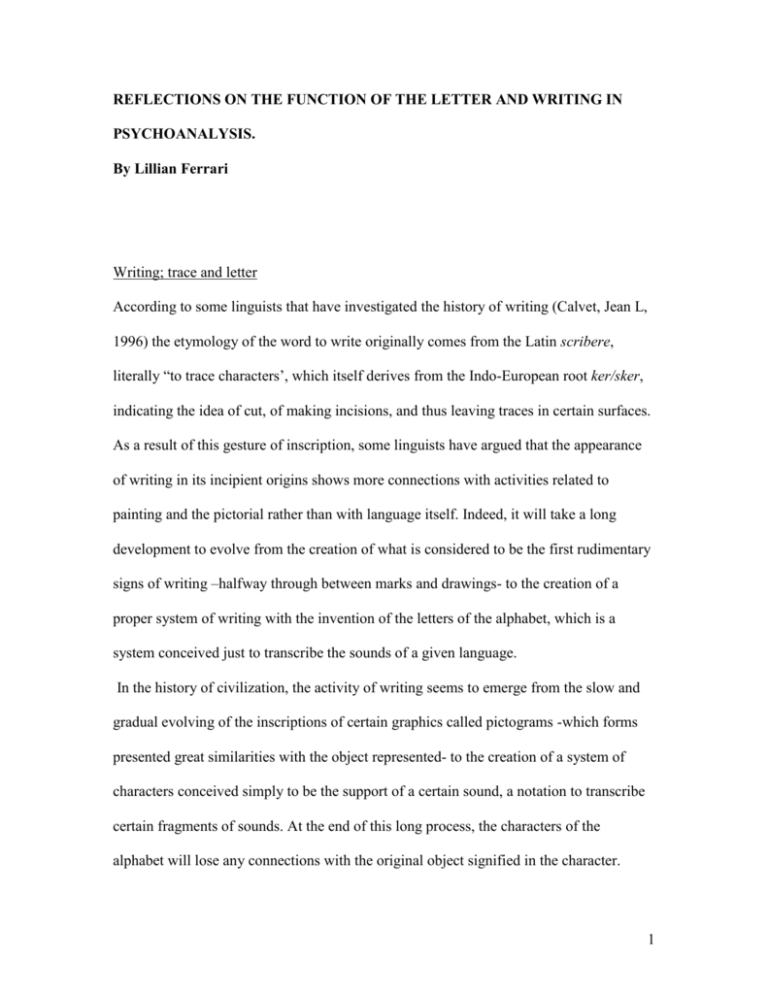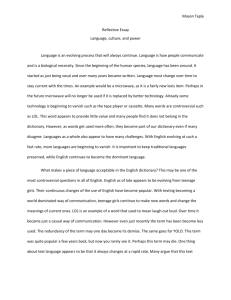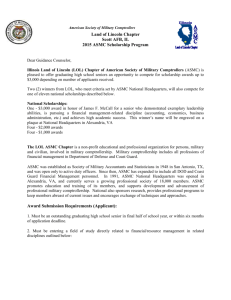Function of the Letter and Writing in Psychoanalysis
advertisement

REFLECTIONS ON THE FUNCTION OF THE LETTER AND WRITING IN PSYCHOANALYSIS. By Lillian Ferrari Writing; trace and letter According to some linguists that have investigated the history of writing (Calvet, Jean L, 1996) the etymology of the word to write originally comes from the Latin scribere, literally “to trace characters’, which itself derives from the Indo-European root ker/sker, indicating the idea of cut, of making incisions, and thus leaving traces in certain surfaces. As a result of this gesture of inscription, some linguists have argued that the appearance of writing in its incipient origins shows more connections with activities related to painting and the pictorial rather than with language itself. Indeed, it will take a long development to evolve from the creation of what is considered to be the first rudimentary signs of writing –halfway through between marks and drawings- to the creation of a proper system of writing with the invention of the letters of the alphabet, which is a system conceived just to transcribe the sounds of a given language. In the history of civilization, the activity of writing seems to emerge from the slow and gradual evolving of the inscriptions of certain graphics called pictograms -which forms presented great similarities with the object represented- to the creation of a system of characters conceived simply to be the support of a certain sound, a notation to transcribe certain fragments of sounds. At the end of this long process, the characters of the alphabet will lose any connections with the original object signified in the character. 1 Thus, the system of writing emerges properly when all its initial traces of the figurative, of the proximity with the object or idea represented, is lost. Lacan rescues from this process a notion of effacement that is contained in the idea of a trace, because the gesture of effacement is essential for the constitution of the subject of the unconscious. Lacan takes up this idea of effacement as operative in the letter in a text he wrote in 1971, Lituraterre, where he explores the relationship between Psychoanalysis and writing. In fact, the word ‘Lituraterre’ is a neologism, a play on several words and their different semantic domains, which illustrates what in fact is involved in the notion of the letter in Psychoanalysis. We have the term litura, liturarious from the Latin, which means to cross out, to efface, or to correct; then, there is the idea of the littoral, a coastal area in which two distinctive substances, water and earth, shared a common border; additionally, the signifier ‘letter’ and its Joycean slippage to the word litter, trash, conveys the link of the letter with the function of the remainder, the privilege object that serves as a vehicle for jouissance. By playing with the homophony between littoral and literal, Lacan wants to convey firstly, that the function of the letter is to localize certain effects of the signifier, as in certain equivocations or word-play: “That the letter is the proper instrument for writing discourse does not render it improper to designate the word taken for an other, even by an other, in the sentence, thus to symbolize certain effects of the signifier, but this does not impose that the letter is primary in these effects”(Lituraterre, 3). The letter permits an opening, a new reading through which one can go beyond the literal meaning initially intended in the text. Secondly, implicit in the notion of littoral is the idea of a border, of a frontier between two domains that are not “reciprocal”, such as knowledge (savoir) that 2 comes from the articulation of signifiers, and jouissance (the jouissance of the body), conveying the sense that the letter also borders something of the real, of that which escapes its articulation in language: “the edge of the hole in knowledge, isn’t it this that the letter outlines?”(Lacan 3) In his book “Transmettre la Clinique psychoanalytique” (trans. Ed. Nueva Vision, 2004) Eric Porge conveys with a beautiful expression the notion of the link between the letter and the litter that is reflected in the neologism Lituraterre when he states that ultimately Lacan’s aspiration for the transmission of Psychoanalysis was to produce “a poetics of the rubbish”. Why? Because he wanted to find a way for the transmission of psychoanalysis that would resonate with the nature of the subjective truth, a truth that –as Freud taught us- is not the Truth in capital letters, but rather a half truth revealed through the least important, through those ‘insignificant’ occurrences neglected by the Official Knowledge such as slip of the tongues, forgetfulness, jokes, myths and dreams. Duras These two dimensions are very much present in the writings of French writer Margarite Duras, and it is through one of her novels “The Ravishment of Lol V Stein” that I want to approach the relationship between writing and Psychoanalysis. This novel, indeed a very beautiful and strange novel conveys a deeply understanding of the structure of love, desire and the nature of subjective suffering, with a writing technique that it is as precious as it is thrift. Jacques Lacan, in a short essay written in 1965 gives homage to the writings of Margarite Duras, praising the novel and the writer for having artfully expressed something that resonates with the unconscious structure of desire, insofar as 3 human desire is always supported in a fantasy that resembles a certain ‘staging’, a performance in which each character’ role is intertwined with the other as in a knot. Something is being articulated in the novel-in the content of the novel, as well as in the form- that advances questions that are particularly relevant for the analyst. Lacan says (1965) ‘That is precisely what I acknowledge to be the case in the ravishing of Lol V. Stein, where it turns out that Margarite Duras knows, without me, what I teach,’ (139). In this sentence, is he referring to the episode in the novel that describes the ravishment of Lol, or is he referring to the novel itself which title is, precisely, The Ravishment of Lol V Stein? It seems to me that in the novel this two aspects -the content of the story and the form, that is, the manner in which the novel is written as reflected by the choice of words, the names of the characters, the voice of the narrator, etc- are inextricable linked, becoming at times indistinguishable, thereby conforming a surface, a texture in which its inside is in contiguity with its outside, echoing in this manner the surface of the unconscious. In his praising, he goes as far as to say that this beautiful novel reveals once again- that the practice of the letter coincides with the workings of the unconscious (139) leaving in suspense whose unconscious is at stake: Lol’s unconscious? Margarite Duras’? Ours as readers? It is obvious from the first pages of the novel that, in her writings M Duras subverts the roles traditionally assigned to the position of the subject and the object in the narrative, making it difficult to realize who is talking, or rather from which place those words are spoken; the voice of the narrator switches from the 3er person to the first in a manner that left us puzzle as to who controls the narrative, or from where emanates the look from which the story is told. 4 The title of the novel raises an interrogation: Should “The ravishing of Lol V Stein” be taken in subjective or objective terms? In other words, Is Lol the subject of this ravishing or are we, as readers the one who are being ravished by the novel? Taken to the letter, both possibilities seem equally true. So let me summarize the story: Lol –whose real name is Lola Valerie Stein- is a beautiful and young American who is engaged to be married with a handsome and wealthy man called Michael Richardson. During a ball that takes place in the Casino of the Beach where they are vacationing, he has a chance and fateful encounter with another mysterious and beautiful woman, Ann Marie Stretter. It will take just an instant –the instant of the look- for these two to recognize their sudden and mutual passion as they proceed to the dance floor. In the mean time, Lol can not help but watch the scene in fascination, unable to move or scream, her eyes glue to the dancing couple at the moment in which she is about to be robbed of her lover. “If she herself had been the agent not only of its advent but of what would come of it, Lol could not have been more fascinated by it.” (The Ravishment, p.8) But strikingly, Lol does not present any sign of suffering or pain: “As the evening wore on, it seemed that the chances that Lol might suffer were growing increasingly slim…”(9). Lol’s crisis will take place only at the end of the ball, when the breaking of dawn announces that the time of concluding is near. As if she has been awaken from a dream, she desperately tries to arrest time, to immobilized the scene while screaming that “it was not late”(12) Late for what or for whom? After the fateful scene of the ball, Lol collapses in a state of crisis but there is no indication that she is going through a mourning process, no allusion to the loss of her fiancé, or to her sense of abandonment and betrayal. Instead, she will repeat “how boring, how long it was, how interminable it was to be Lol Stein”(14). Eventually she 5 will recover –at least she will give that impression-, get married, have children and move out of her childhood town. After ten years however –ten uneventful years- she comes back to S. Thala, the town where the traumatic scene had taken place. There, in what one may think is an attempt at reconstituting the scene of the ball, she hooks up with another couple of lovers, Tatiana Karl –who was a childhood friend and witness at the ballroom scene- and Jack Hold, the man who is also (we learn this with a certain surprise halfway through the novel) the narrator of the novel. When Jack enters, the voice switches from the omniscient third person to the “I”, the first person narrator. The establishment of a time of enunciation marks the emergence of the subject’s desire. Jack falls in love with Lol and it is essentially through his speech –proving once again that the Desire is the desire of the Other- that Lol becomes present, yet ever more elusive. Who is Lol? What does she want? Throughout the novel Lol is presented to us as an elusive and mysterious creature, someone whose intentions are difficult to fathom, seemingly lacking any passions or definitive preferences that would permit one to place her somewhere, to characterize her. She carries herself with a constant air of absence, almost indifference in her interactions with others; her friend Tatiana remarks “…In school, there was something lacking in Lol, she was already then, strangely incomplete, she had lived her early years as though she were waiting for something she might, but never did, become” (71) And “Lol was funny… and very bright, even though part of her seemed always to be evading you, and the present moment…There was already something lacking in Lol, something which kept her from being, in Tatiana’s words, ‘there’.”(3) In French ‘there’ reads “lá” which is interestingly, the same syllable that is contained in Lol’s name, shortened for Lola. Something of this impossibility of being… ‘there’ -but also being at 6 the level of her coming to existence- is inscribed in her name that is reflected in the dropping of the letter a; the name with the missing letter a is repeated so many times in the novel that we can not pay attention to it: strange, incomplete, almost anonymous, as if something of this absence that characterizes her is contained in the name. This feature that marks Lol’s name is echoed by her silence, by her seemingly inability to find a word to name her pain, the pain of separation from the other. This separation –a separation that at the level of the structure expresses an effect of language insofar as language is a mediation that ultimately precludes any relation of immediacy- is double: its a separation with a part of our body, and also a separation with the other; indeed creating the function of the other. This separation is structurally connected to the function of what Lacan designates object a which could be understood in light of Freud’ concept of the ‘lost object’, which means that as a result of the entrance of the subject in the field of language the subject experiences an irremediable loss of any adequate, natural relationship with an object, including one’s own body as a libidinal object. Consequently, any object will be a refound object, and never identical to the original ‘mythical’ one. This loss, however, will cause the subject’s desire to search for its re-finding it, eventually permitting him/her to establish libidinal connections with numerous others. The fall of this object is the condition that permits both, the constitution of one’ own narcissistic body, and the constitution of the subject’s desire that sustains itself in the fantasy. In the case of our bodily image, the effect of this fall takes the form of a detachment that separates the narcissistic body from the body as a ‘living organism’, as a result of which we have a body and not a piece of flesh. To have a body and “not to be a 7 body” is a consequence of language since the body itself is captured in the network of signifiers that the Other –parents and significant others- transmits to the child, a transmission that includes their ideals as well as their unconscious desires. This capture implies ultimately that the relationship that we maintain with our body is at the same time intimate, yet strange and distant because the mediation that language interposes precludes any form of immediate, direct relationship with it. In the last instance the image of our body, made up with words and representations, will function as a veil to cover up the ‘real’ of the body, otherwise inaccessible. We may conjecture that in Lol’ case there occurred a certain failure in the process of inscribing her into the dimension of the Other, into a dimension that condenses not only the symbolic and cultural aspects of the place into which a child is born, but also the unconscious desires and fantasies of the progenitors; this failure is noticeable at the level of her nomination, as if this very important act with all its subjective consequences, did not fully conclude for her. As a result of this failure something remains without articulation, unnamable and unspeakable, never really able to become a memory, and yet persisting in its real presence as a hole, as a gap, as a hole-word, as the place where speech itself encounters its own limit, its own impossible to articulate. It is this very limit of speech that Duras’ prose makes vibrate embodied in the figure of Lol, somehow conveying the moment of the emergence of speech, this almost original moment in which each and every word has the potential to bring meaning, yet at the same time it causes silence to emerge as inextricable linked to language. It is precisely the presence of this hole what will center all efforts on the part of Jack Hold to produce a narrative. Inevitably, he will fall in love with her enigma, striving to snatch a word from her, and in 8 so doing, pushing her more and more to the point of madness. In Margarite Duras writing, this unnamed that Lol’s name somewhat evokes is condensed in the following passage: “ She has no memory, not even an imaginary one, she has not the faintest notion of this unknown. But what she does believe is that she must enter it… that it would always have meant, for her mind as well as her body, both their greatest joy and their greatest pain, so commingled as to be indefinable, a single entity but unnamable for lack of a word. I like to believe -since I love her- that if Lol is silent in her daily life it is because, for a split second, she believed that this word might exist. Since it does not, she remains silent. It would have been an absence-word, a hole-word, whose center would have been hollowed out into a hole, the kind of hole in which all other words would have been buried…by its absence, this word ruins all the others, it contaminates them, it is also the dead dog on the beach at high noon, this hole of flesh.” (38) We may interrogate what is the meaning of this rather abrupt, almost brutal appearance of the real of the body conveyed in the figure of the ‘dead dog in the beach’ that the text raises in conjunction with the “hole-word”. The impact of this figure is not simple to be found at the level of the content –a level that could always be deceptive in its appeal to a “profound dimension”- but is rather reinforced by the structure of the syntaxes: placed almost at the end of a long sentence it produces a rather arresting effect, as if somehow the presence of this odd element interrupted the continuity of the thoughts that were being conveyed, suspending, at least temporarily the dimension of a beyond that is always possible to evoke through speech. The presence of this odd element that resonates together with the ‘hole-word’ creating a feeling of vacuity, isn’t it evocative of the function of the stain, of the dark spot in the visual field which brings about the function 9 of what Lacan calls the object a as “pure gaze’? Strikingly, that is exactly the manner in which Margarite Duras describes Lol in another scene of the novel, a moment which appears to be an attempt on her part to recreate the “event” as one may call it, of the ballroom scene. Lol has followed Tatiana and Jack to the Hotel were they are about to meet for their rendezvous, and placing herself within the landscape of rye that surrounds the building, she watches the couple of lovers from this vantage point, as they appear through the opening of the room’s window. “ Before her is that lighted window…the shadow of a man crosses the rectangle of light…In turn, Tatiana Karl, naked in her black hair, crosses the stage of light…Lol does not stir…she knows that unless they had been forewarned of her presence in the field, they would not be able to detect her. Tatiana does not see the dark spot in the rye.” (Duras 56). We have here all the elements that characterizes the structure of the fantasm, in this case framed by the opening of the room’s window, that anticipates the pathos of the moment of the constitution of the subject at the moment where she is about to fall, transfixed by that moment in all its ambiguity of fascination and rejection, in which she is about to experience her body as waste, as a reminder left by the other’s desire. In terms of the structure, this moment though, corresponds to the vanishing of the subject, a vanishing that the subject submits to by virtue of his being represented by the signifier, there where this representation requires at the same time its disappearance and its absence so that the signifier can take its place. This subjective vanishing, this moment of eclipse that the subject experiences as an effect of his/her representation in the signifying chain is what the fantasm tries to portray, staging the moment in which the subject is in the verge of falling. And that is why the actions that are frequently represented in the scene of the fantasm (being beaten, 10 mutilated, defecated, etc.) are different ways in which the subject portrays imaginarily this moment of ‘fading’. The construction of the fantasy –or the fantasm in Lacanian terms- bears witness to the fact of the effectiveness of the operation of castration insofar it is after the loss of the object that the subject may have access to desire and enjoyment. In the case of Lol, though, it is doubtful that in setting up this ‘scenario’, she is trying to portray her own ‘falling’ as object a connected with the gaze. She does not seem to be taking the position of the one who finds ‘enjoyment’ –albeit a torturous enjoyment- by spying on the lovers, but rather the one who, placed outside the window, does not see: she embodies the non-look. Lol appears ‘deceptively’ to want to look, however as Lacan insists, she is not in the position of the voyeur, the perverse subject who aims at imposing his fetish gaze into the other. As her position outside the window suggests, Lol is rather the embodiment of the function of the gaze, which in principle can be understood not as an objective relation between the subject and its objects, but as a libidinal one; for Lacan the constitution of the visual field implies a doubling up between the gaze and the image, there where the gaze can also be conceived as non-look in so far as the libidinal constitution of the gaze requires always a point of non-visibility. This point of non-visibility is evocative of the blind look –as for instance in the case of hysterical blindness- and of the ‘odd’ element in the landscape, insofar as any odd element, by standing out forces one to look at it. In that sense, Lol as ‘the dark spot in the field of rye’ makes present the function of the stain that structurally accompanies the constitution of the image. Why? We can read the presence of this dark spot that somehow disturbs the peacefulness of the landscape as conveying the moment in which the gaze is originated, representing the point of origin in which our 11 desire is motivated. Indeed, what causes the subject’s desire, including his/her desire to look is a lack, an absence. As any other desire, my desire to see is triggered by a lack, by an absence that the stain or dark spot aptly conveys because it marks precisely the place of the non visible, the point where the image falters. Through this point of non-visibility, the stain makes present that which is necessary to subtract from the visual field in order to cause the gaze to emerge. Says Lacan again in the Homage “You can verify it, the gaze is everywhere in the novel. And the woman of the event is easy to recognize, since Margarite Duras has depicted her as non-gaze (non-regard)” (140). If this look – regard in French- looks at you without looking at you is in the sense that we say that some matter requires one’s attention, that one can not help but ‘take a look at it’ because it concerns oneself, “forcing oneself’ –whether we like it or not- to direct one’s attention to it. There is another aspect that is inevitable connected with the question of the gaze, and that again is possible to hear through the letters of the novel. This aspect concerns the possibility of the gaze becoming a “voracious eye”, a destructive force that carries the potential to consume everything that it coveted, becoming the ‘evil eye’ that Lacan evokes in Seminar 11 (1964) with the term facinum. In that sense, Lol as non look is evocative of the power of the gaze as fascimun, having the power to fascinate, the power to somehow summon a magical effect, enchanting us but also posing the danger to disarm, to immobilized, arresting the movement of life that is ultimately evocative of the presence of death. 12 The fact that in the novel Lol has to sustain with her real presence the fantasmatic scene –placing herself outside the window opening as if watching, whereas in fact she can’t see anything- suggest a structure where there has been no detachment of the object a as a metaphor for castration, no ‘piercing’ affecting a part of her body that would account for the emergence of an erogenous body, which ultimately implies a body that could be experienced, enjoyed, and even suffered. None of this appears to happen for Lol, where she seems to lack a subjective experience of her body, carrying her body as some kind of thing that one ought to take or to move from here to there, something like an object that one pulls from one place to another, but not knowing exactly what to do with it. ”She is still asking herself where this body ought to be, where exactly to put it, so that it will cease to be burden to her (The Ravishing, 163) In my view, the operation of the cut that establishes the relation between the subject and its object of desire remains inconclusive, and this lack of conclusion maintains her fixed to the scene in the position of remainder, a remainder however that does not end up falling. Once again this inconclusiveness resonates with your name, Lol, where the very letters of your name configure a trait that can be equally read from the right side to the left side, where the beginning meets the end, giving the impression that one can reverse interminable from one to the other…loosing oneself in the eternity of the ball in the cinema of Lol V. Stein”(Duras 39). Lillian Ferrari 13 WORKS CITED Calvet, Louis-Jean. Historia de la Escritura. Buenos Aires: Paidos.2008 Duras, Marguerite. The Ravishing of Lol Stein. New York: Pantheon Books. 1966. Lacan, Jaques. Homenage to Marguerite Duras, on Le Ravissement de Lol V. Stein. In Writing and Psychoanalysis. Trans. By Peter Conor. Ed. by John Lechte. Great Britain: Arnold, 1996. Lacan, J. Lituraterre. Published in the Journal Litterature, 1971 and reprinted in Ornicar? Revue du Champ freudien. Paris. 1987 14








